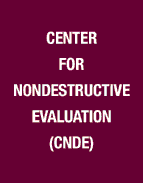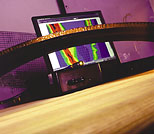

Center for Nondestructive Evaluation (CNDE)
Iowa State University
A National Science Foundation Industry/University Cooperative Research Center since 1985
Advances in nondestructive evaluation can enhance the quality and reliability of manufactured products; these same noninvasive measurement techniques are beginning to find application in biological systems
Center Mission and Rationale
Nondestructive evaluation is the use of measurement techniques to non-invasively determine the integrity of a material component or structure. The Center for Nondestructive Evaluation (CNDE) uses quantitative approaches to develop nondestructive evaluation as an engineering tool applicable throughout the life cycle of a structural component. The Center's traditional emphasis has been in the fields of aviation, transportation, energy, and manufacturing, with a mission of conducting directed research that advances the science of nondestructive evaluation and ensures the integrity of structures and materials. These same techniques are now being extended to the development of solutions to agricultural, biomedical, and food processing problems.

|
Research Program
CNDE conducts a full spectrum of research ranging from the development of measurement models, which describe the fundamental interaction between probing methods and the flaws and properties of materials, to the development of one-of-a-kind prototype instruments. Areas in which the Center is currently conducting research include --
- Ultrasonics
- Electromagnetic measurements
- Radiographic techniques
- Magnetic techniques
- Signal processing techniques
- Pattern recognition and AI techniques
- Nondestructive characterization of materials
- Fluorescent penetrants.
Because the field of nondestructive evaluation requires a multidisciplinary approach, contributions from various engineering disciplines and physical and life sciences are essential. Faculty and scientific staff from 4 colleges and 15 departments have contributed to the research efforts at Iowa State University (ISU). The Center's researchers currently include more than 35 faculty members and full time research staff, as well as some 35 graduate and postdoctoral students and 15 undergraduate students.
In addition to participating in the Industry/University Cooperative Research Centers Program, CNDE is active in other major research programs --
- The Center for Aviation Systems Reliability (CASR) and Engine Titanium Consortium (ETC) are research and technology development programs funded by the Federal Aviation Administration (FAA). These programs help provide solutions to pressing aircraft structures and engine nondestructive inspection (NDE) and maintenance problems. Beneficiaries include commercial airline operators and engine and airframe OEM's in the United States and abroad.
- The program on Image-Guided Surgery, funded by the Roy J. Carver Charitable Trust, explores the application of quantitative NDE techniques to gaining improved information about the condition of various tissue structures that can help physicians make more rapid and accurate decisions during surgery.
- The Iowa Demonstration Laboratory is an outreach effort funded by Iowa State University to aid in technology transfer to Iowa businesses.
Special Center Activities
Some of the Center's research, technology transfer, and education/training accomplishments include --
- Demonstrated a family of new techniques for characterizing materials, both structural and biological, based on energy-dispersive X-ray measurements
- Extended ultrasonic measurement models to include the effects of cabling and pulser/receiver characteristics that are known to strongly influence industrial test results
- Demonstrated the use of X-ray and ultrasonic modeling techniques to guide the refinement of medical imaging procedures
- Converted X-ray, eddy current, and ultrasonic simulation software to operate on PC platforms, a process that is rapidly accelerating the industrial use of these tools
- Developed a new class of model-based procedures for determining the probability of flaw detection and demonstrated their advantages on aircraft engine and pipeline applications
- Developed a second-generation pulsed eddy current system, able to characterize corrosion in multi-layer aircraft skins
- Invented a computer-assisted tap tester that greatly reduces the operator influence on determining disbonds in honeycomb panels and that is currently being evaluated by several companies for licensing
- Improved NDE technical education through the North Central Collaboration for Education in NDE/NDT (in cooperation with four community colleges). A major component was the development of improved educational materials, including lessons based on X-ray simulation software and web-based Java applets demonstrating the major measurement modalities
- Improved the design component of materials science education at Iowa State University by integrating NDE simulation software into a course on concurrent engineering
- Laid the foundation for more uniform NDE education and standards world-wide through the formation of the World Federation of NDE Centers.
Many companies have used advances developed by CNDE in their manufacturing and service businesses.
Facilities
Most of CNDE's facilities are housed in ISU's Applied Sciences Complex. CNDE research equipment and instrumentation include a comprehensive set of X-ray sources and detectors, high- and low-frequency ultrasonic instruments, ultrasonic phased array equipment, cw and pulsed eddy current instrumentation, photoinductive equipment for characterizing eddy current probes, special purpose equipment for making a variety of magnetic-based NDE measurements in the laboratory and field, a unique "testbed" for validation of models and work related to the role of NDE and materials in concurrent engineering and life cycle management, and a PC-based cluster for performing parallel computations on large-scale problems. In addition, examples of all of the major equipment items used by industry in practical inspections are available.
Center Headquarters
Center for Nondestructive Evaluation
Iowa State University
Applied Sciences Complex II
1915 Scholl Road
Ames, IA 50011-3042
Tel (515) 294-8152 * Fax (515) 294-7771
Homepage: http://www.cnde.iastate.edu
Center Director: Dr. R. Bruce Thompson cnde@cnde.iastate.edu
Center Evaluator: Dr. Anton J. Netusil (515) 232-6463 * netusil@iastate.edu
NSF 01-168vv